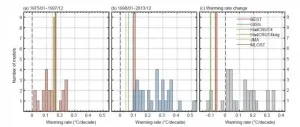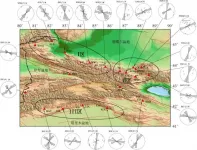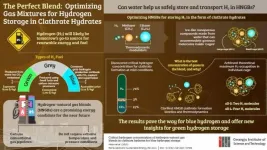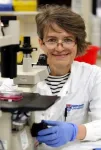Scientists find new way of predicting COVID-19 vaccine efficacy
Australian researchers have identified the immune response associated with protection from COVID-19 - a discovery that may help cut the time it takes to develop new vaccines.
2021-05-17
(Press-News.org) (SYDNEY, Monday 17th May 2021) The early immune response in a person who has been vaccinated for COVID-19 can predict the level of protection they will have to the virus over time, according to analysis from Australian mathematicians, clinicians, and scientists, and published today in Nature Medicine.
The researchers from UNSW's Kirby Institute, the Peter Doherty Institute for Infection and Immunity, and the University of Sydney have identified an 'immune correlate' of vaccine protection. This has the potential to dramatically cut development times for new vaccines, by measuring neutralising antibody levels as a 'proxy' for immune protection from COVID-19.
"Neutralising antibodies are tiny Y-shaped proteins produced by our body in response to infection or vaccination. They bind to the virus, reducing its ability to infect," says Dr Deborah Cromer from the Kirby Institute.
"While we have known for some time that neutralising antibodies are likely to be a critical part of our immune response to COVID-19, we haven't known how much antibody you need for immunity. Our work is the strongest evidence to date to show that specific antibody levels translate to high levels of protection from disease."
The researchers analysed data from seven COVID-19 vaccines to examine the how the response measured soon after vaccination correlated with protection. They then used statistical analysis to define the specific relationship between immune response and protection. Their analysis was remarkably accurate and was able to predict the efficacy of a new vaccine.
Dr Cromer said that this finding has the potential to change the way we conduct COVID-19 vaccine trials in the future.
"Antibody immune levels are much easier to measure than directly measuring vaccine efficacy over time. So, by measuring antibody levels across the range of new vaccine candidates during early phases of clinical trials, we can better determine whether a vaccine should be used to prevent COVID-19."
Vaccine boosters likely to be required within a year
Another crucial application of this analysis is its ability to predict immunity over time. The researchers predict that immunity to COVID-19 from vaccination will wane significantly within a year, with the level of neutralising antibodies in the blood dropping over the first few months following infection or vaccination.
"Vaccination works very well to prevent both symptoms and severe disease in the short to medium term, but efficacy is predicted to decline over the first few months for most of these vaccines," says Dr David Khoury, also from the Kirby Institute.
"However, it is very important to understand the difference between immunity against infection and protection from developing severe disease. Our study found that a 6-fold lower level of antibodies is required to protect against severe disease. So even though our analysis predicts that we will start losing immunity to mild infection in the first year after vaccination, protection from severe infection should be longer lived," says Dr Khoury.
"But ultimately, for optimal protection against moderate disease and transmission of COVID-19, these findings suggest we may be looking at annual vaccine boosters, just like what we have with the flu vaccine."
Applying the model in the real word
A major global challenge is the evolution of the virus and the emergence of new variants. There is a growing concern, based on laboratory studies, that antibodies developed against the dominant strains are less effective at neutralising these new variants.
"An added advantage of our work is that allows us to predict how protective an immune response will be against different variants," says Professor Jamie Triccas from the University of Sydney's Marie Bashir Institute and Faculty of Medicine and Health.
"This analysis shows a very good correlation between the immune response - which is very easy to test for - and the efficacy of a vaccine in preventing infection, which is incredibly hard to test for. This means we can predict how protective an immune response will be against different variants, without having to determine efficacy against each variant in large and costly clinical trials.
"This work can facilitate decision making by providing the necessary data much earlier on in the vaccine development pipeline and in a far more efficient way."
A limitation of this study is that it analyses the relationship between early immune responses to infection and vaccination and protection from infection (the data that is currently available), and uses this relationship to project how immunity will change in the future and in the response to different viral variants. Future studies should aim to confirm these predictions as data becomes available.
INFORMATION:
ELSE PRESS RELEASES FROM THIS DATE:
2021-05-17
A weather pattern that pushes snowfall away from parts of Greenland's ice sheet is causing the continent to become darker and warmer, according to Dartmouth research published in Geophysical Research Letters.
The reduction in the amount of fresh, light-colored snow exposes older, darker snow on the surface of the ice sheet. The resulting decrease in reflectivity, known as albedo, causes the ice to absorb more heat, also likely contributing to faster melting.
"As snow ages, even over hours to a few days, you get this reduction in reflectivity, and that's why the fresh snow is so important," said Erich Osterberg, associate professor of earth sciences at Dartmouth and the principal investigator of the study.
According to the ...
2021-05-17
A new study led by Dr. Wei and Dr. Qiao from the First Institute of Oceanography, Ministry of Natural Resources provides an evaluation of the performance of the newly released CMIP6 models in simulating the global warming slowdown observed in the early 2000s. This study reveals that the key in simulating and predicting near-term temperate change is to correctly separate and simulate the two distinct signals, i.e., the human-induced long-term warming trend and natural variabilities, especially those at interannual, interdecadal and multidecadal scales. This work was online published in SCIENCE CHINA Earth Sciences on April 15th, 2021.
After the unprecedented warming over the last quarter of the 20th century, the global surface temperature growth slowed unexpectedly during ...
2021-05-17
The collision between the Indian and Eurasian plates resulted in the formation of the Tianshan Tectonic Belt; however, the formation mechanism of Tianshan and the construction of a dynamic model explaining it remain to be achieved and an integrated understanding has not been reached. A new study adopted shear-wave splitting system to collect and analyze shear-wave splitting parameters of 33 stations in the Tianshan area, it provides new evidence for potentially enhance the understanding the dynamic mechanism of the Tianshan tectonic belt.
The research paper is titled:"Anisotropic zoning in the upper crust of the Tianshan Tectonic Belt, Published in Science China Earth Sciences Issue 4, 2021, Corresponding author ...
2021-05-17
In our ongoing quest to transform into a more eco-friendly society, hydrogen (H2) is heralded as the clean fuel of tomorrow. Because H2 can be produced from water (H2O) without generating carbon emissions, developing H2-compatible technologies has become a top priority. However, the road ahead is bumpy, and many technical limitations must be ironed out. "Hydrogen is the smallest molecule in nature, and finding feasible ways to store it is a critical issue to realize a hydrogen economy," states Associate Professor Youngjune Park from the Gwangju Institute of Science ...
2021-05-17
WASHINGTON, DC--People with cardiovascular disease (CVD) taking aspirin to lower their chances of suffering a heart attack or stroke experienced similar health benefits, including reduced death and hospitalization for heart attack and stroke, whether they took a high or low dose of aspirin, according to a study presented today at ACC.21, the American College of Cardiology's 70th Annual Scientific Session and published in the New England Journal of Medicine.
CVD--and atherosclerosis, in particular, which is a narrowing and hardening of the arteries--is a leading cause of death for men, women, and most racial and ethnic groups in the United States, with estimated direct costs of END ...
2021-05-17
New research has shown that people with type 1 diabetes may have features of premature heart disease induced by the condition often before they even get their diagnosis.
Early markers for this heart disease could be used to ensure patients get targeted therapies as soon as they are diagnosed with type 1 diabetes to slow down or even halt cardiovascular problems.
The findings, published in Stem Cell Research and Therapy, show that tiny pieces of genetic material, called miR-424-5p, increased in early stages of heart disease - these could be targeted to help reduce inflammation in order to compensate for elevated risk.
Early heart disease
Dr Jolanta Weaver, from Newcastle University's Faculty of Medical Sciences, UK, ...
2021-05-17
There's been a breakthrough in the case of the missing planets.
While planet-hunting missions have discovered thousands of worlds orbiting distant stars, there's a severe scarcity of exoplanets that measure between 1.5 and two times Earth's radius. That's the middle ground between rocky super-Earths and larger, gas-shrouded planets called mini-Neptunes. Since discovering this 'radius gap' in 2017, scientists have been sleuthing out why there are so few midsize heavenly bodies.
The new clue arose from a fresh way of looking at the data. A team of researchers led by the Flatiron Institute's Trevor David investigated whether the radius gap changes as planets age. They divvied up exoplanets into two groups -- young and old -- and reassessed the gap. The ...
2021-05-17
The blood thinner apixaban was not superior to standard of care following transcatheter aortic valve replacement (TAVR), according to findings from a new trial called ATLANTIS presented at the American College of Cardiology's 70th Annual Scientific Session. Researchers found that while apixaban reduced the formation of blood clots (thrombosis) around the implanted valve with no increased bleeding risk, a subset of patients taking apixaban who did not have an indication for anticoagulation apart from the TAVR procedure showed a tendency toward a higher rate of non-cardiovascular death--a ...
2021-05-17
Transcatheter left atrial appendage occlusion (LAAO) with a WATCHMAN device was associated with a low rate of stroke at one year even among older patients with atrial fibrillation (AFib) who faced a high risk for stroke or bleeding based on their previous health history, according to new data presented at the American College of Cardiology's 70th Annual Scientific Session.
The WATCHMAN device, which blocks a small portion of the heart to help reduce the risk of a dangerous clot forming, was approved by the U.S. Food and Drug Administration in 2015. The device is used to reduce the risk of stroke in patients with AFib, a heart rhythm disorder, that is not caused by problems with the heart valve. ...
2021-05-17
Patients with an elevated risk of stroke due to heart rhythm problems, or atrial fibrillation (AFib), were much less likely to suffer a stroke after undergoing heart surgery if doctors concurrently performed an additional procedure, called left atrial appendage occlusion (LAAO), according to the results of a trial presented at the American College of Cardiology's 70th Annual Scientific Session.
AFib increases a person's risk of stroke or systemic embolism, which are life-threatening conditions caused by blood clots blocking an artery. It has been hypothesized that the blood clots that cause these conditions often originate in the left atrial appendage, a small sac on the upper left chamber of the heart. LAAO is a procedure to ...
LAST 30 PRESS RELEASES:
[Press-News.org] Scientists find new way of predicting COVID-19 vaccine efficacy
Australian researchers have identified the immune response associated with protection from COVID-19 - a discovery that may help cut the time it takes to develop new vaccines.





